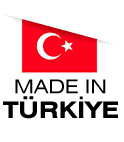Reverse Osmosis Systems



Reverse Osmosis Systems; Membrane filtration process for obtaining pure water, which is applied to waters where conventional treatment systems are insufficient (sea water, water with high conductivity, well water, etc.), separating all unwanted minerals in the water from the water, is called Reverse Osmosis. Osmosis is a natural phenomenon and in short, it is the passage of water from a less dense medium to a highly dense medium. This process continues until the osmotic balance is achieved. Reverse osmosis, on the other hand, is the reversal of this osmotic flow.
Reverse Osmosis Systems successfully provide pure water as a result of this process. Reverse Osmosis Systems, on the other hand, can be produced according to different design and design styles according to customer requests.
Reverse Osmosis Standard Features
- Membrane sleeves FRP
- TFC Spiral wound membranes 8″ diameter
- AISI 304 and AISI 316 quality pressure pump
- ST-37 or AISI304 Stainless steel chassis
- Cartridge filter with 5 micron precision
- Low pressure line U-PVC PN16
- High pressure line AISI 304 Stainless steel
- Butterfly valve with inlet electric actuator
- Pump outlet and flow regulating valve
- Low and high pressure switch
- Product water and waste water flow meters
- Glycerin manometers
- Product water conductivity (0-2000µS/cm)
- Product water pH meter (optional)
- Autoflush, automatic flushing System
- On-Off switch
- PLC and operator panel
- 380 V/50Hz/3ph
- Control Panel
Recommended Inlet Water Values …

- Inlet water TDS: 0 – 2,000 ppm
- Working pressure: Between 10 and 15 bar
- Inlet water pressure: 2 to 5 bar
- ASC dosage is required if the hardness is more than 3 French
- pH range: 6 – 8
- Silica (SiO2) Tolerance: 25 ppm max. @ 60% efficiency
- Max. Inlet water temperature = 30º C Max.
- Max Iron (Fe) tolerance: 0.05 ppm, 0.2 ppm if ASC is dosed
- It should not be Hydrogen Sulfide.


